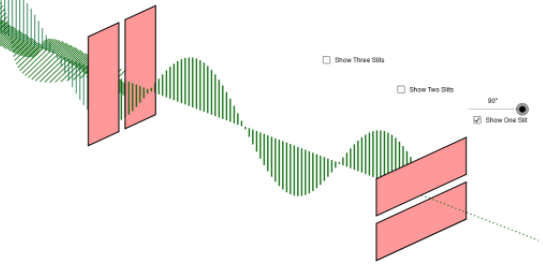
Which of the below properties explains electromagnetic waves are also known as transverse waves?
A.Polarization
B.Interference
C.Reflection
D.Diffraction
Answer
523.8k+ views
Hint: Only transverse waves can be polarized longitudinal waves cannot be polarized. If an electromagnetic wave is polarized it will show that electromagnetic waves are transverse in nature.
Complete answer:
Transverse waves are those waves in which direction of propagation of wave is perpendicular to direction of oscillations of constituent of wave. Longitudinal waves are those waves in which direction of propagation of wave is along the direction of oscillations of constituent waves.
Polarization is the phenomena in which wave oscillations align themselves in a particular direction after being passed through a polarizer. The light coming from the sun, bulb, etc. is generally unpolarized light. This means wave oscillations, i.e. the oscillations of electric fields, do not have a specific direction and are oscillating in random directions. When a polarizer is kept in the path of this light, it obstructs all of the oscillations which are not all its axis and allows only oscillation of that specific orientation to pass through it. If we place another polarizer (which will now become analyzer) along the path such that its axis is not aligning with the axis of the previous polarizer the intensity of light will get reduced. And if the polarizer is kept perpendicular to the previous polarizer the intensity of light will become zero as shown in the figure below.
This is the evidence that light becomes polarized after passing through the first polarizer (because now no light is able to pass through the analyzer which means all the oscillations were perpendicular to the analyzer and hence were in direction of polarizer). This shows that Electromagnetic waves can be polarized.
Polarization is a property of transverse waves. No longitudinal wave can be polarized. This is because in longitudinal waves direction of oscillations is already in a specific direction i.e. direction of propagation of wave. They are not oscillating in random directions. So by this explanation we concluded that polarization is the property which shows Electromagnetic waves are also known as transverse waves.
Hence option A is the correct answer.
Note:
The phenomena of interference, diffraction and reflection are properties of waves. They can be exhibited by both longitudinal as well as transverse waves. Hence if any wave shows this property it is not necessarily a transverse wave. Polarization is a characteristic property of transverse waves. Hence Polarization is evidence of a wave being transverse.

Complete answer:
Transverse waves are those waves in which direction of propagation of wave is perpendicular to direction of oscillations of constituent of wave. Longitudinal waves are those waves in which direction of propagation of wave is along the direction of oscillations of constituent waves.
Polarization is the phenomena in which wave oscillations align themselves in a particular direction after being passed through a polarizer. The light coming from the sun, bulb, etc. is generally unpolarized light. This means wave oscillations, i.e. the oscillations of electric fields, do not have a specific direction and are oscillating in random directions. When a polarizer is kept in the path of this light, it obstructs all of the oscillations which are not all its axis and allows only oscillation of that specific orientation to pass through it. If we place another polarizer (which will now become analyzer) along the path such that its axis is not aligning with the axis of the previous polarizer the intensity of light will get reduced. And if the polarizer is kept perpendicular to the previous polarizer the intensity of light will become zero as shown in the figure below.
This is the evidence that light becomes polarized after passing through the first polarizer (because now no light is able to pass through the analyzer which means all the oscillations were perpendicular to the analyzer and hence were in direction of polarizer). This shows that Electromagnetic waves can be polarized.
Polarization is a property of transverse waves. No longitudinal wave can be polarized. This is because in longitudinal waves direction of oscillations is already in a specific direction i.e. direction of propagation of wave. They are not oscillating in random directions. So by this explanation we concluded that polarization is the property which shows Electromagnetic waves are also known as transverse waves.
Hence option A is the correct answer.
Note:
The phenomena of interference, diffraction and reflection are properties of waves. They can be exhibited by both longitudinal as well as transverse waves. Hence if any wave shows this property it is not necessarily a transverse wave. Polarization is a characteristic property of transverse waves. Hence Polarization is evidence of a wave being transverse.

Recently Updated Pages
Why are manures considered better than fertilizers class 11 biology CBSE

Find the coordinates of the midpoint of the line segment class 11 maths CBSE

Distinguish between static friction limiting friction class 11 physics CBSE

The Chairman of the constituent Assembly was A Jawaharlal class 11 social science CBSE

The first National Commission on Labour NCL submitted class 11 social science CBSE

Number of all subshell of n + l 7 is A 4 B 5 C 6 D class 11 chemistry CBSE

Trending doubts
What is meant by exothermic and endothermic reactions class 11 chemistry CBSE

1 Quintal is equal to a 110 kg b 10 kg c 100kg d 1000 class 11 physics CBSE

What is periodicity class 11 chemistry CBSE

What is a periderm How does periderm formation take class 11 biology CBSE

Mention the basic forces in nature class 11 physics CBSE

What are porins class 11 biology CBSE




